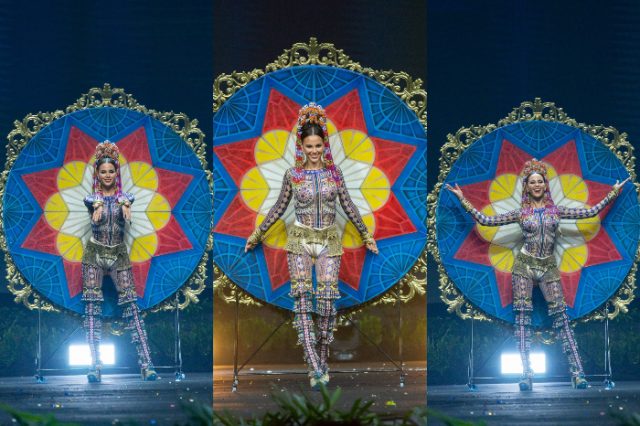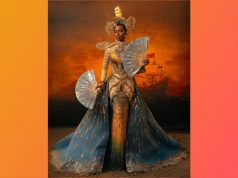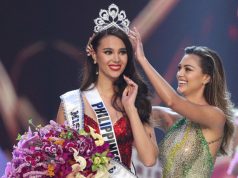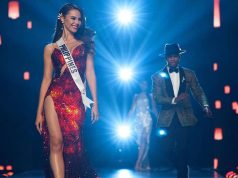A collaboration of local artists was behind the standout national costume of Catriona Gray, the representative of the Philippines at Miss Universe 2018, during the pre-pageant event on Monday, December 10.
Gray wore a body suit with intricate prints, a colorful headdress and boots, and carried a large, oval backdrop with a lantern design as she strutted at the Nong Nooch International Convention Center in Thailand’s Pattaya City.
The ensemble called “LuzViMinda” is inspired by the diverse cultures of the country’s biggest islands, Luzon, Visayas and Mindanao.
It gathered praises from many people here and abroad. She was also featured on many posts on Vogue Thailand’s Instagram page.
So totoo pala yung sinabi ni Catriona Gray na “i will bring the whole Philippines with me” in her national costume—accessories from Mindanao, body suit from Visayas and lantern inspired “wings” from Luzon. Pak! #MissUniverse2018 pic.twitter.com/bRxZqwrXwG
— rey (@overrey) December 10, 2018
Born out of research
Gray said that her goal is to represent the diversity of cultures in the Philippines at the pageant. To fulfill this, she, her mentor Carlos Buendia Jr. and fashion designer Jearson Demavivas, consulted historians and talked to experts for the costume.
“I want to represent the Philippines in all forms. When people see the Philippine sash, it’s just a word on a sash, but really, we’re made up of so many different places and so much different aspects to our culture,” she said in an interview with ABS-CBN.
She recalled that she discussed her concepts first with Buendia, who was a former artistic director of a theater organization at the University of Santo Tomas. They then presented it to Demavivas, who made a sketch of it, tweaking it as needed.
The coronation night will be held in Bangkok on December 17.
Parts of the ‘LuzViMinda’
Each part of her outfit highlights a particular culture or belief in an island. Demavivas and Buendia explained each component of the costume in their Instagram posts.
Backdrop. The backdrop is a giant lantern or parol that represents the world-renowned lanterns from the province of Pampanga in Luzon with the theme “Magdiwang” or “Celebrate.”
The Giant Lantern Festival is a grand year-end celebration in San Fernando, Pampanga that attracts many tourists every year.
Eric Quiwa, a lantern artisan in Pampanga, used the yellow and blue parol motif on one side while UST graduates created the intricate paintings on the other.
This is the first time in #MissUniverse history that a Parol from Pampanga was used as an inspiration for the National…
Posted by Pampanga on Monday, December 10, 2018
The Baybayin script at the edges of the parol, meanwhile, tells part of the lyrics of the national anthem.
Demavivas also said the collage of artworks convey a deeper message.
“The painting also highlighted victories, festivals, events, heroes and national icons with a style inspired by the works of Philippine National Artist Carlos ‘Botong’ Francisco, a native of the Art Capital of the Philippines, Angono, Rizal in Luzon,” he said.
Furthermore, the brass border of the piece was inspired by the aesthetic of the baroque churches in the Philippines that are declared as UNESCO heritage sites.
Pattern. The pattern in Gray’s bodysuit is derived from the Pintados tattoo art of indigenous Filipinos from the Visayas. It is themed “Lumaban” or “to fight.”
Demavivas explained that the patterns are authentic as these are based on the ancient manuscript called Boxer Codex written in the 1590s. The Boxer Codex contains illustrations of native Filipinos during the early conflict with Spanish invaders.
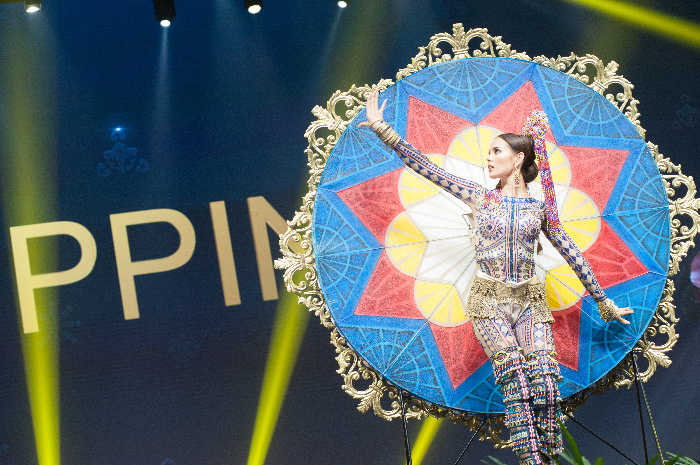
Headpiece and accessories. The culture of Mindanao is evident in her headpiece and brass accessories from South Cotaboto and embroidered knee-high boots. It is themed “Pagyamanin” or “Enrich.”
It was well-known shoemaker Jojo Bragais who designed her boots. He drew inspiration from the indigenous textile patterns by the ethnic groups Inaul, Yakan, Maranao, B’laan, Bagobo, Tausug and T’nalak.
“The woven textiles express a strong belief in “ancestral and natural spirits” and “cultural roots” of indigenous communities that remain well-preserved up to this day,” Demavivas said.

